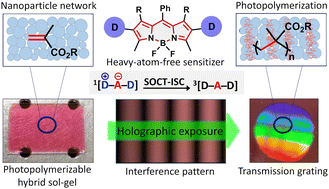Charge transfer mediated triplet excited state formation in donor–acceptor–donor BODIPY: Application for recording of holographic structures in photopolymerizable glass†
Abstract
Donor–acceptor–donor BODIPY triads bearing anthracene or pyrene as electron donating subunits were prepared through a stepwise synthesis. Photoinduced electron transfer and formation of long-lived triplet excited states via spin–orbit charge transfer intersystem crossing (SOCT-ISC) was studied by steady-state and ultrafast pump-probe spectroscopy and further supported by DFT computations. New BODIPYs were found to form triplet states and sensitize singlet oxygen in both polar and non-polar solvents which is unusual for photosensitizers operating via SOCT-ISC. BODIPY-anthracene triad (ABA) was used as a photosensitizer component in a photopolymerizable glass that was prepared by a four-step sol–gel process. ABA in combination with N-phenylglycin (NPG) showed the ability to initiate a free-radical polymerization of methacrylate monomers under 532 nm irradiation thus allowing for holographic recording of diffractive structures. High diffraction efficiency (up to 87%) obtained for ABA-NPG containing glass as compared to a reference diiodo-BODIPY (I2BDP) demonstrates for the first time that heavy-atom-free SOCT-ISC photosensitizers can efficiently operate in the solid state.



 Please wait while we load your content...
Please wait while we load your content...